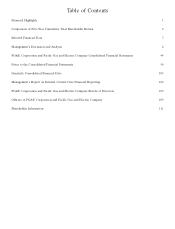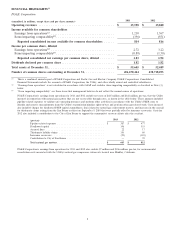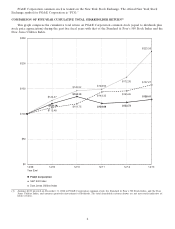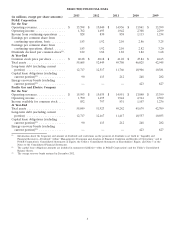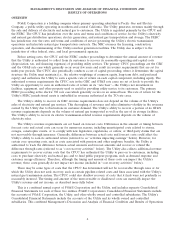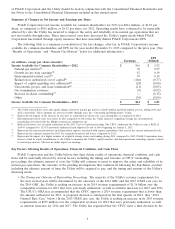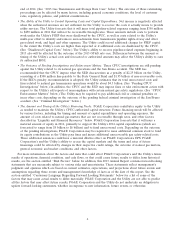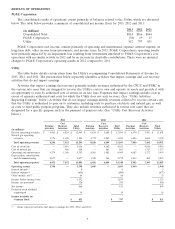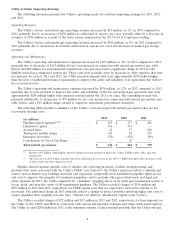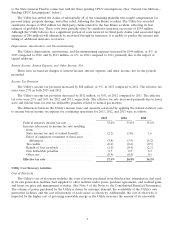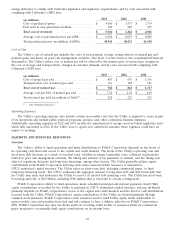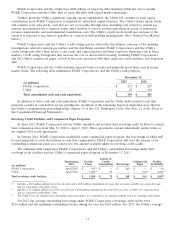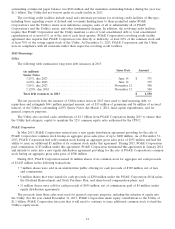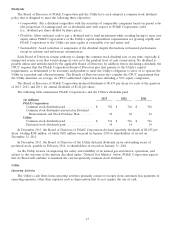PG&E 2013 Annual Report Download - page 10
Download and view the complete annual report
Please find page 10 of the 2013 PG&E annual report below. You can navigate through the pages in the report by either clicking on the pages listed below, or by using the keyword search tool below to find specific information within the annual report.MANAGEMENT’S DISCUSSION AND ANALYSIS OF FINANCIAL CONDITION AND
RESULTS OF OPERATIONS
OVERVIEW
PG&E Corporation is a holding company whose primary operating subsidiary is Pacific Gas and Electric
Company, a public utility operating in northern and central California. The Utility generates revenues mainly through
the sale and delivery of electricity and natural gas to customers. The Utility is regulated primarily by the CPUC and
the FERC. The CPUC has jurisdiction over the rates and terms and conditions of service for the Utility’s electricity
and natural gas distribution operations, electric generation, and natural gas transportation and storage. The FERC
has jurisdiction over the rates and terms and conditions of service governing the Utility’s electric transmission
operations and interstate natural gas transportation contracts. The NRC oversees the licensing, construction,
operation, and decommissioning of the Utility’s nuclear generation facilities. The Utility also is subject to the
jurisdiction of other federal, state, and local governmental agencies.
Before setting rates, the CPUC and the FERC conduct proceedings to determine the annual amount of revenue
that the Utility is authorized to collect from its customers to recover its reasonable operating and capital costs
(depreciation, tax, and financing expenses) of providing utility services. The primary CPUC proceedings are the GRC
and the GT&S rate case which generally occur every few years and result in revenue requirements that are set for
multi-year periods. The CPUC also periodically conducts a cost of capital proceeding, where it determines the capital
structure the Utility must maintain (i.e., the relative weightings of common equity, long-term debt, and preferred
equity) and authorizes the Utility to earn a specific rate of return on each capital component, including equity. The
authorized revenue requirements the CPUC sets in the GRC and GT&S rate cases are set at levels to provide the
Utility an opportunity to earn its authorized rates of return on its ‘‘rate base’’—the Utility’s net investment in
facilities, equipment, and other property used or useful in providing utility service to its customers. The primary
FERC proceeding is the electric TO rate case which generally occurs on an annual basis. The rate of return for the
Utility’s FERC jurisdictional assets is embedded in revenues authorized in the TO rate cases.
The Utility’s ability to recover its GRC revenue requirements does not depend on the volume of the Utility’s
sales of electricity and natural gas services. This decoupling of revenues and sales eliminates volatility in the revenues
earned by the Utility due to fluctuations in customer demand. The Utility’s ability to recover a portion of its GT&S
revenue requirements depends on the volume of natural gas transported as well as the use of its storage facilities.
The Utility’s ability to recover its electric transmission-related revenue requirements depends on the volume of
electricity sales.
The Utility’s revenue requirements are set based on forecast costs. Differences in the amount or timing between
forecast costs and actual costs can occur for numerous reasons, including unanticipated costs related to storms,
outages, catastrophic events, or to comply with new legislation, regulations, or orders; or third-party claims that are
not recoverable through insurance. Generally, differences between actual costs and forecast costs could affect the
Utility’s ability to earn its authorized return (referred to as ‘‘activities impacting earnings’’ below). However, for
certain core operating costs, such as costs associated with pension and other employee benefits, the Utility is
authorized to track the difference between actual amounts and forecast amounts and recover or refund the
difference through rates (referred to as ‘‘cost recovery activities’’ below). The Utility also collects additional revenue
requirements to recover certain costs that the CPUC has authorized the Utility to pass on to customers, including
costs to purchase electricity and natural gas; and to fund public purpose programs, such as demand response and
customer energy efficiency. Therefore, although the timing and amount of these costs can impact the Utility’s
revenue, these costs generally do not impact net income (included in ‘‘cost recovery activities’’ below).
There may be some types of costs that the CPUC has determined will not be recoverable through rates or for
which the Utility does not seek recovery, such as certain pipeline-related costs and fines associated with the Utility’s
natural gas transmission system. The CPUC could also disallow recovery of costs that it finds were not prudently or
reasonably incurred. The timing and amount of the unrecoverable or disallowed costs can materially impact the
Utility’s revenue and net income, as described more fully below.
This is a combined annual report of PG&E Corporation and the Utility, and includes separate Consolidated
Financial Statements for each of these two entities. PG&E Corporation’s Consolidated Financial Statements include
the accounts of PG&E Corporation, the Utility, and other wholly owned and controlled subsidiaries. The Utility’s
Consolidated Financial Statements include the accounts of the Utility and its wholly owned and controlled
subsidiaries. This combined Management’s Discussion and Analysis of Financial Condition and Results of Operations
4



